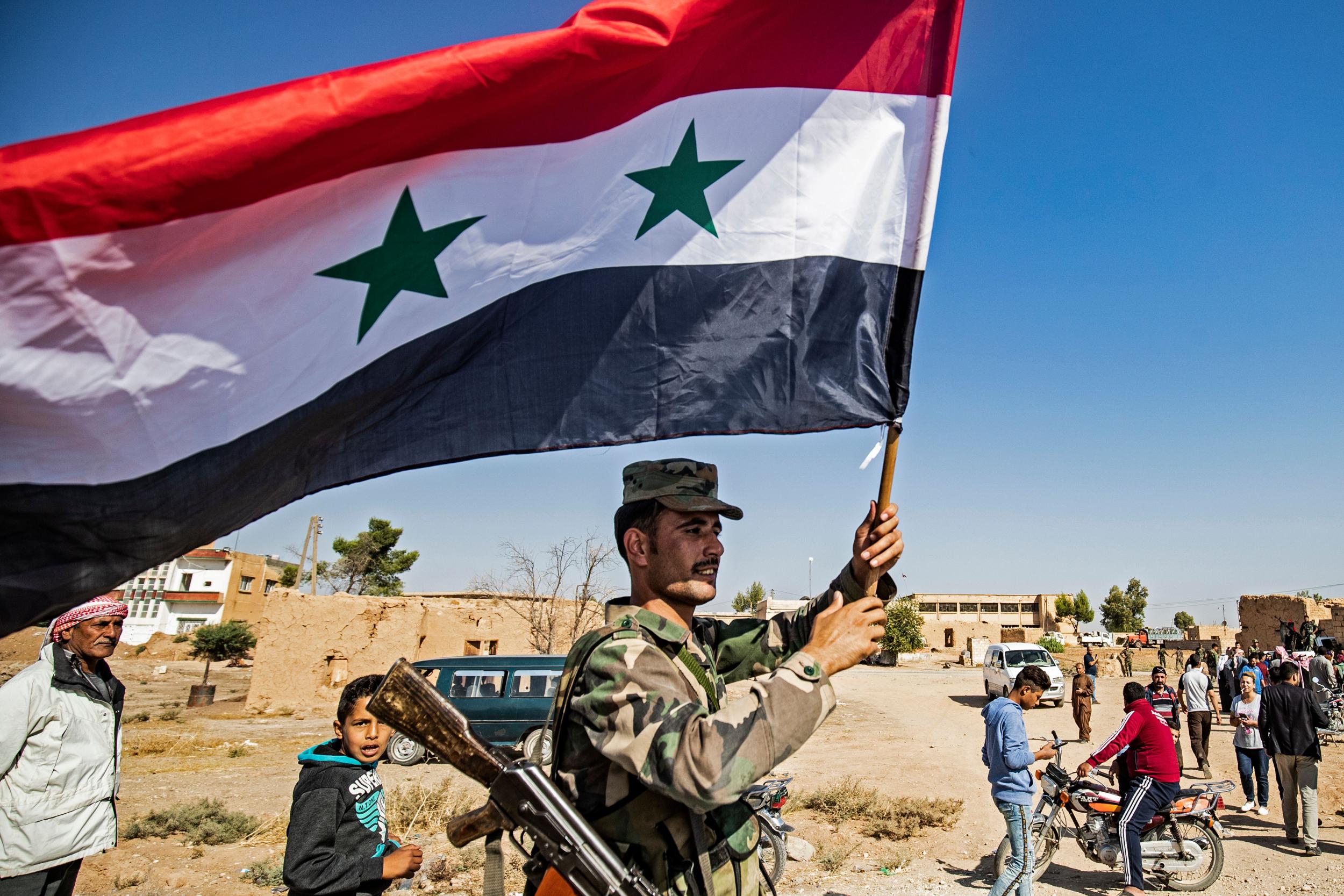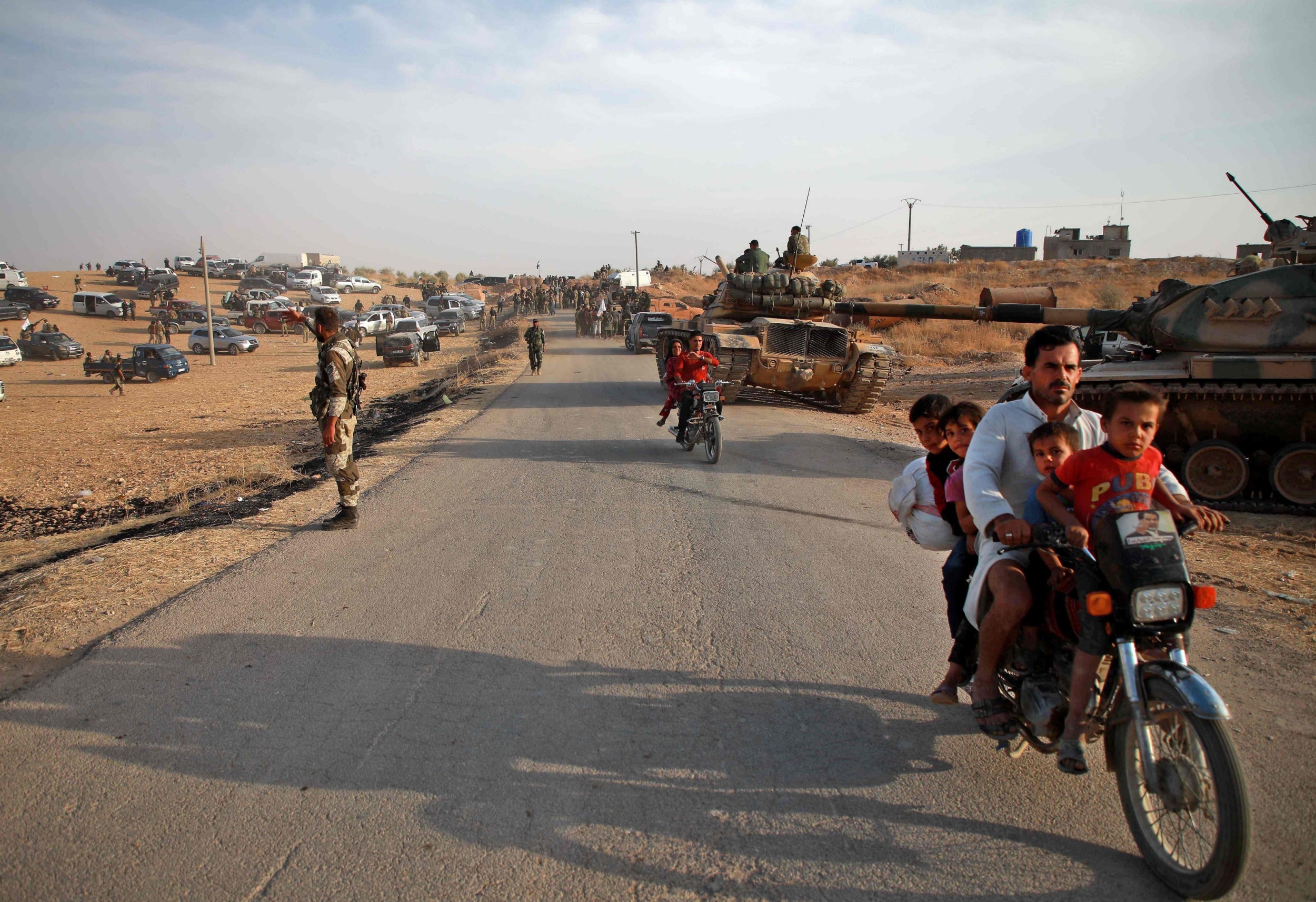Return of Assad’s forces to Kurdish areas brings relief for now, but fear for future
Kurds and Arabs see dangers in return of Syrian government forces in northeast Syria, but immediate relief, writes Richard Hall

Your support helps us to tell the story
From reproductive rights to climate change to Big Tech, The Independent is on the ground when the story is developing. Whether it's investigating the financials of Elon Musk's pro-Trump PAC or producing our latest documentary, 'The A Word', which shines a light on the American women fighting for reproductive rights, we know how important it is to parse out the facts from the messaging.
At such a critical moment in US history, we need reporters on the ground. Your donation allows us to keep sending journalists to speak to both sides of the story.
The Independent is trusted by Americans across the entire political spectrum. And unlike many other quality news outlets, we choose not to lock Americans out of our reporting and analysis with paywalls. We believe quality journalism should be available to everyone, paid for by those who can afford it.
Your support makes all the difference.Seven years ago, while it was failing to contain an insurgency that was sweeping the country, the Syrian government withdrew from the Kurdish northeast without a fight. Now, it may soon return in much the same way.
Over the course of the Syrian civil war, the Kurdish-led Syrian Democratic Forces (SDF) has grown from a small underground movement into a powerful military force in control of a third of the country.
With support and weapons from the US to fight against Isis, Syria’s Kurds were afforded a level of protection that allowed them to pursue a long-held dream of building an autonomous administration, which they hoped would outlast the war.
But in just a week, it all came crashing down. The withdrawal of US protection, abruptly announced by president Donald Trump, opened the door for Ankara to attack its longtime enemy, which it considers a terror group for its links to a Kurdish separatist movement inside Turkey.
After a week of intensive bombing and civilian casualties, and facing what one commander called “an existential threat”, the SDF was forced on Sunday evening to strike a deal with the Syrian government.
In the towns and villages that stand in the path of the planned Turkish operation, there is now a sense of relief that the Syrian government may be able to halt Turkey’s advance, but also fear that the last seven years of improving freedoms may disappear.
“It’s very concerning,” says Kawa, a resident of the city of Qamishli. “A lot of humanitarian aid workers will be questioned. Young boys who are eligible for military service will be questioned. Many politicians who are opposed to the government too.”
“It will not be an easy situation. But at least children, the elderly and women will be safe.”
The memories of repression under Syrian government rule are still fresh in the minds of many Kurds. For decades, the community was treated as second-class citizens in Syria, and faced restrictions on where and when they could speak their language and celebrate their culture.
The Syrian government’s withdrawal from most of northeast Syria changed that. As it battled to destroy the Isis caliphate, the SDF also set up local councils and other nascent democratic structures.
Sirwan Muhammed, a 51-year-old truck driver, also from Qamishli, says the deal with Damascus was a matter of life and death.
“I know the regime well and I lived for 50 years under it. But we are forced to stay in the regime because the people would be slaughtered. For this reason I cannot deny that my heart is heavy,” he says.
“If we are conscious, that we, as a people, are going to be exterminated, we would not just make agreements with the regime, but with the devil,” he adds.
The threat is just as acute, if not more so, in Arab majority areas further south. People in the city of Raqqa rose up against the Syrian government in the early days of the war, and although it is not thought to be included in the SDF agreement as it stands, some there see it as the beginning of a gradual return of Assad’s authority.
“It will be a disaster,” says Ahmed, a resident of Raqqa. “Ninety per cent of young people here are wanted by the government for military conscription. Thousands of people were also involved in supporting the Syrian revolution, both charges could put them in jail,” he says.
More than 100,000 people are thought to have disappeared into Syrian government jails, according to the Syrian Network of Human Rights. Thousands have been executed in those facilities.
“The sad thing is that we lost our homes and our relatives and now were are back to zero, back to Assad rule,” adds Ahmed.
In the days since the deal was announced, hundreds of aid workers and foreign journalists have fled to the border, fearing they too might be arrested by Syrian government forces.
The full details of the agreement are reportedly still being discussed. But in a statement announcing the deal, the SDF said the army would deploy along the border with Turkey “to repel this aggression and liberate the areas entered by the Turkish army and its hired mercenaries”.
We are like a drowning man who tries to clutch at anything he can
Syrian government forces have already been seen moving towards Manbij, just west of the Euphrates, and will reportedly take positions in Kobani and Qamishli, at opposing ends of the proposed safe zone.
What is still unclear is the long-term impact the move will have on the institutions built by the SDF over the last few years.
Since it was announced late on Sunday, SDF officials have insisted that the agreement is only a military deal, and that negotiations would continue over a political settlement. But some analysts see the deal as the first step in an eventual dismantling of the SDF’s autonomous project.
“While the general lines of the deal entails mutual self-defence and jointly fighting Turkey, long-term it spells the end of complete autonomy for the Kurds and forces them to come to terms with Damascus calling the shots in the north,” says Danny Makki, a British Syrian analyst with contacts in the Syrian government.
“After the deal is fleshed out in the coming weeks and finer details are agreed upon with Russian mediation, the Kurds will still retain an element of self-rule and come under Russian patronage,” he says, adding that the deal amounted to a “temporary understanding and coordination”.

But to figure out what comes next, some are looking to other areas of the country that reconciled with the Syrian government. In many places where former rebels struck deals with the Assad regime, arrests and crackdowns followed.
“The regime will likely agree to a deal that appears to grant the Kurds some rights, and then work, systematically, to undermine the deal and regain full control,” says Elizabeth Tsurkov, of the Foreign Research Policy Institute, who has studied previous reconciliation deals with the government.
“This is its pattern of operation in the Homs countryside and Daraa and Quneitra, where some rebels secured deals through Russia and were offered minimal protections.”
Some, however, still hold out hope that the SDF can use its strength to prevent a full takeover by the government.
“We must keep our flags,” says Beritan Muhammad, a 31-year-old office worker in Qamishli who was displaced from Afrin.
“We lost a lot of lives to defend this place, we gave blood, we have lived in exile, we have struggled. What we have built up must remain: our flag, our autonomy, our language. We want to keep all this, since we have participated in this revolution,” she adds.
Muhammed, the truck driver, was more pessimistic: “We are like a drowning man who tries to clutch at anything he can."
Join our commenting forum
Join thought-provoking conversations, follow other Independent readers and see their replies
Comments